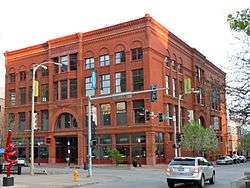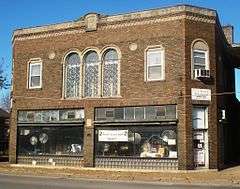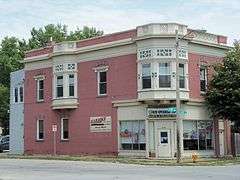Kahl Building
|
Kahl Building | |
|
| |
  | |
| Location |
326 W. 3rd St. Davenport, Iowa |
|---|---|
| Coordinates | 41°31′21″N 90°34′41″W / 41.52250°N 90.57806°WCoordinates: 41°31′21″N 90°34′41″W / 41.52250°N 90.57806°W |
| Area | 1 acre (0.40 ha) |
| Built | 1920 |
| Architect | Arthur Ebeling |
| Architectural style | Early Commercial |
| MPS | Davenport MRA |
| NRHP Reference # | 83002456[1] |
| Added to NRHP | July 07, 1983 |
The Kahl Building, also known as Kahl Education Center, is an historic building located in Downtown Davenport, Iowa, United States. It was listed on the National Register of Historic Places in 1983. The building also includes the Capitol Theatre.
Kahl Building
The Kahl Building is ten-stories tall and rises 146 feet (45 m) above the ground.[2] It was designed by Davenport architect Arthur Ebeling who used as inspiration the works of Chicago architects William Holabird, John Root and Louis Sullivan.[3] In fact Sullivan’s Wainwright Building in St. Louis is considered a model after which the Kahl Building was designed.[4] Sullivan's influence can be seen in the more elaborate ornamentation on the lower floors while the upper floors are relatively plain.[5] Their decoration is confined to recessed spandrel panels. The building is capped with a staccato pairing of round-arch windows and an elaborate cornice.
In 1920, the building was constructed by Henry Kahl and Walsh-Kahl Construction for $1.5 million.[4] It is composed of steel frame construction with stone and decorative terra cotta facing materials. The building's sense of height is highlighted by recessing the spandrel panels between the floors and behind the vertical piers.[3] It is considered an "exceptional example of the influence of the Chicago School on commercial architecture."[4] Historically, the building has contained 184 office suites, several retail shops, a restaurant and the Capital Theater.[4]
In 1994 the family of Davenport Banker V.O. Figge and his wife Elizabeth, who was Henry Kahl's daughter, donated the building to the Scott Community College Foundation, which now uses it for academic purposes. The Eastern Iowa Community Colleges announced in August 2014 their intention to leave the Kahl Building and relocate to a new campus that will be created in the former First Federal Bank and First Midwest Bank buildings on West Third Street between Brady and Main streets. The $50 million project includes renovating the Kahl Building into 80 market-rate apartments.[6]
Capitol Theatre
The Capitol Theatre opened on December 25, 1920. Builder Henry C. Kahl wanted to provide a 2,500-seat, palace-type theater. Kahl planned a luxurious movie theater larger than any in Davenport or Iowa. When opened, the theater boasted grand pianos, gold leaf decoration, and several chandeliers. Its interior was designed by the Chicago firm of Rapp & Rapp.[2] The original pipe organ was built by the M. P. Moller Pipe Organ Company. It was replaced by a Wicks pipe organ for $30,000,[4] and contains 700 pipes.[7] The organ received a $75,000 restoration in 2000, and it is now the only Wicks theater organ that remains in its original home.[4] In 1925, a 10-story stage house and stage expansion were constructed. The theater started to show movies in the 1950s and discontinued operating as a working movie theater in 1977. The theater joined the Radio-Keith-Orpheum (RKO) circuit in 1927. A variety of performers have performed on its stage including vaudeville shows. It hosted the Winter Dance Party in 1959 that included Buddy Holly, the Big Bopper and Richie Valens before their deaths five days later in an airplane crash outside of Clear Lake, Iowa.[7] The Capitol currently has a capacity of 1,550 seats, but is no longer in operation. The $50 million renovation of the Kahl Building would include the Capitol Theatre and turn it into a first-run movie theater again.[6]
References
- ↑ National Park Service (2009-03-13). "National Register Information System". National Register of Historic Places. National Park Service.
- 1 2 "Kahl Building/Capitol Theater". Emporis. Retrieved 2012-08-05.
- 1 2 Svendsen, Marls A., Bowers, Martha H (1982). Davenport—Where the Mississippi Runs West: A Survey of Davenport History & Architecture. Davenport, Iowa: City of Davenport. pp. 6–9.
- 1 2 3 4 5 6 Iowa Department of Cultural Affairs - State Historical Society of Iowa. "Kahl Building/Capitol Theatre" (PDF). Davenport Public Library. Retrieved 2010-03-08.
- ↑ Martha Bowers, Marlys Svendsen-Roesler. "Kahl Building" (PDF). National Park Service. Retrieved 2015-04-16.
- 1 2 Barb Ickes (2014-08-12). "EICC, Restoration St. Louis to partner on $50M downtown project". Quad-City Times. Retrieved 2015-04-16.
- 1 2 "Facts about the Capitol Theatre". Quad-City Times. 2010-04-06. Retrieved 2012-08-05.


